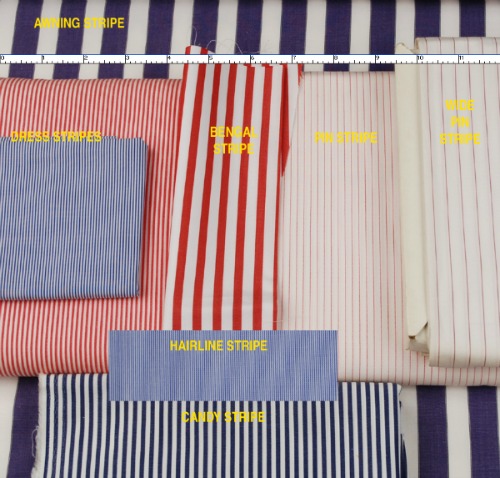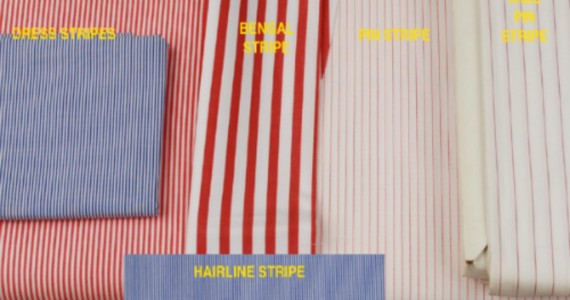There are a lot of types of shirt stripes out there. Even if you only include the most common types It’s hard to keep them all straight. That’s probably why world renowned shirt maker Alexander Kabbaz put together a post on Ask Andy 12 years ago on the subject that I still find myself revisiting to this day.
 The image above features examples of Awning Stripes, Dress Stripes, Bengal Stripes, Candy Stripes, Hairline Stripes, Pin Stripes, and Wide Pin Stripes along with a measuring tape making it a great reference piece.
The image above features examples of Awning Stripes, Dress Stripes, Bengal Stripes, Candy Stripes, Hairline Stripes, Pin Stripes, and Wide Pin Stripes along with a measuring tape making it a great reference piece.
These are relative sizes. For example, Candy Stripes approximately 1/8″ equally spaced white & color or color & color; Bengal Stripes +/- 1/4″ equally spaced white & color or color & color, etc. Pin stripes are usually 1 or two yarns thick and the spacing between pin stripes varies all over the map.
Mr. Kabbaz does note that these are common terms not an all-inclusive list of synonyms and that,
If you’d rather call your Candy Stripes Bengals and your Bengals Pinstripes, feel free. One person’s tiger is another’s kitty.
I actually branched out from my standard blue OCBD this week and ordered a shirt with stripes myself. More on this in the near future. Stay tuned. Until then, here is a link to the full Ask Andy Post that contains additional images and information (visit here).


Just went through the 3 pages of comments on the Kabbaz classification, and it appears that there is little or no agreement on terminology in the U.S., not to mention the US-UK differences.
If I’m not mistaken, there’s also “university stripe”, which seems to be used only when speaking of Oxford cloth.
University stripe and candy stripe appear to be two names for the same thing. L.L. Bean & Lands End use the former term; traditionally, Brooks Brothers used the latter (but I found only one shirt in their current line-up called that, and no “university” stripes); and J Press uses both, but I’m not sure what the difference is with J Press—it seems that it’s the fabric, as you noted.
Jerrod,
Looking forward to your post on branching out from your standard blue OCBD.
I did the same some years ago, first to a white OCBD, and then to button down shirts in pinpoint oxford (first blue, then white) and then to a button down in blue end-on-end. Eventually, I tried stripes. Stripes are more difficult. I’ve never been experimental enough to choose any color stripe other than blue or navy. One has to match the shirt to both the pattern of the tie and the pattern of the jacket. My solution has been to wear nothing but a solid color tie when I wear a striped shirt. If I wear a navy blazer, the tie is burgundy, otherwise it’s navy.
That’s very trad indeed! I’m sure you always look good.
In addition to blue, I have branched out into lavender, pink, and yellow, in both solids and stripes, as well as some checks—windowpane, Glen, tattersall, and the like. Most of my checked shirts are blue & white, but I also have one in pink, white, & blue, and another in yellow & white.
I often wear patterned ties with striped shirts. As Jerrod mentioned, combining stripes & stripes is best done by maximizing the difference in scale between them. It’s easier to combine a striped shirt with a non-striped tie, such as a club tie (game fowl in the autumn & winter, for example), or a paisley, or a neat (a.k.a. foulard). However, it’s never wrong to stick to just one or two patterns, and it’s easier to always look good that way, too.
What you feel comfortable wearing is probably the best choice for you.
Mercer has a banker stripe, which I like very much in navy over grey slacks and under a navy blazer. I agree with any who like the term university stripe, which just “feels” like an Ivy term. I like to think of Bengal stripe as a wide stripe on broadcloth.
Pluperfect – I think that you are correct. It does seem like the term Candy Stripe is used when the material is not an OCBD. Interesting.
Old Trad – Thank you for the encouragement. I will say that a white/blue university stripe OCBD is my go to shirt after the blue OCBD. I love to pair it with khaki chinos, a navy blazer, and a regimental tie. I have found that as long as the stripes are not too narrow that it is a great look. Give a try sometime and let me know what you think.
Etymologue – I am not sure that there will ever be definitive terms for all of the types of stripes, but I found this to be a good jumping off point.